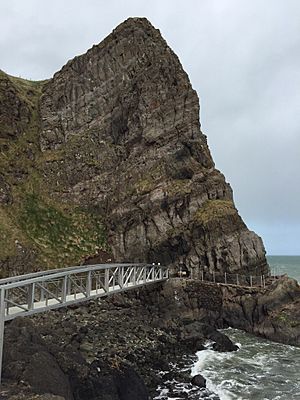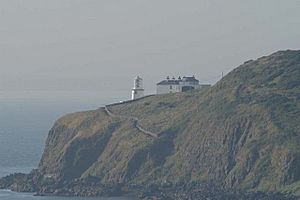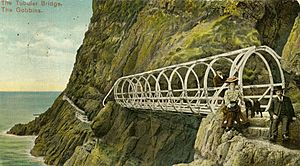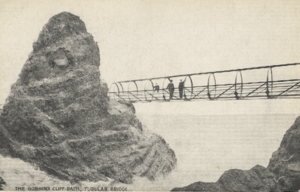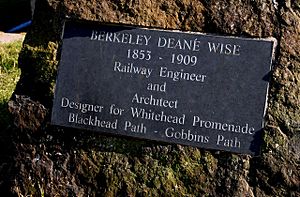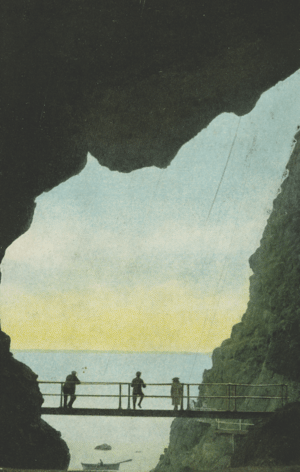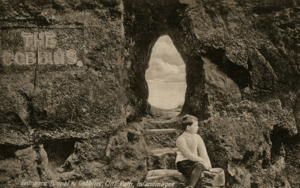The Gobbins facts for kids
Quick facts for kids The Gobbins |
|
|---|---|
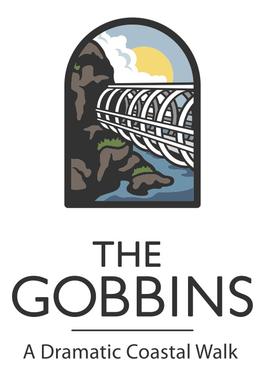 |
|
| Location | Islandmagee County Antrim, Northern Ireland |
| Built | 1902-1908 |
| Built for | Belfast and Northern Counties Railway Company |
| Rebuilt | 2011-2015 |
| Restored by | Larne Borough Council |
| Architect | Berkeley Deane Wise |
| Website | http://thegobbinscliffpath.com |
The Gobbins is an amazing cliff path located in Islandmagee, County Antrim, Northern Ireland. It's part of the beautiful Causeway Coastal Route. The path winds along the Gobbins cliffs, which are known for their many birds, interesting rocks, and special plants and animals. The word Gobán in Irish means "tip of land" or "headland."
An Irish railway engineer named Berkeley Deane Wise designed and built The Gobbins. He created it as a fun place for tourists to visit. The path first opened in 1902. Visitors paid a small fee (6d, which was like a few pence back then) to explore what people called a "perfect marvel of engineering." Newspapers from around the world praised The Gobbins, saying its beauty was "beyond description."
Thousands of people visited The Gobbins in its early years. Advertisements even claimed it had "no parallel in Europe" as a cliff walk. However, the railway company faced money problems in the 1930s. The path was not kept up and closed before World War II. It briefly reopened after the war but closed again in 1954. For many years, people tried to restore it, but it was difficult.
From 2011 to 2015, Larne Borough Council led a big project to reopen The Gobbins. New bridges and walkways were built and put in place. The European Union helped pay for this work. The Gobbins officially reopened to visitors in August 2015, with guided tours. It faced some closures due to storm damage but reopened fully in June 2017. Today, you can find parking, a café, and a visitor centre nearby.
Contents
Building The Gobbins
The Idea for the Path
The idea for The Gobbins came from a clever Irish railway engineer named Berkeley Deane Wise. He was from New Ross. When he was just 22, he helped build tunnels and bridges for a railway line in Ireland. This experience helped him create The Gobbins about 25 years later.
In 1888, Wise became the Chief Engineer for the Belfast and Northern Counties Railway Company. This company already liked to encourage tourism. Another railway leader, Edward John Cotton, had started "excursion trains" and made tickets cheaper. This allowed thousands of ordinary people to travel and enjoy day trips.
Berkeley Deane Wise took tourism to the next level. He created new attractions to make people use the railway. Soon after starting, he opened paths and bridges at Glenariff Glen. He even added a tearoom there. Wise also helped turn the small village of Whitehead into a popular holiday spot. He designed a bandstand, bathing areas, and a large pavilion.
In 1892, Wise built a new path from Whitehead to the lighthouse at Blackhead. To do this, he added several bridges and a tunnel. Soon, he had even bigger plans for a path on the steep cliffs a few miles north. This was the beginning of The Gobbins.
Original Construction Work
Berkeley Deane Wise drew a map of his planned path in 1902. It showed a route about 3.25 miles long. It would start near Ballystrudder village. The path would then follow the coast before reaching the amazing "cliff section." This part would have bridges, tunnels, and caves. This is the famous section that visitors explore today on guided tours. Wise's map gave new names to features along the cliffs, like Sandy Cave and the Man O’War stack.
The first part of The Gobbins opened in August 1902. Scientists were among the first to explore its "strange, fantastic forms." In June 1904, Wise showed the path to other engineers. Their notes describe some details of the original bridges: "The cliff section needed many bridges, from ten to thirty feet long... A sea-stack called ‘The Man-o’War’ is separated from the mainland by a 65-foot gap... Mr Wise designed a special bridge to cross this. The steel frame is 70 feet long..."
This "special bridge" was the famous Tubular Bridge. It quickly became a symbol of The Gobbins.
Extending the Path
When it first opened, the path did not reach the ‘Seven Sisters’ caves. But Wise planned to keep building. In 1905, he received money to extend The Gobbins.
In June 1906, Wise became ill. Another engineer, Bowman Malcolm, took over his job. More work was done, including blasting a tunnel at Trump Cave. Supports for a walkway were built inside another cave. More steps were cut, bridges built, and handrails added along the cliffs.
An extended path opened in 1908. But disaster struck that May: a large landslide broke a bridge and blocked the path. The company decided to maintain the path only as far as it went. No new bridges would be built. Berkeley Deane Wise died in May 1909. He would have been sad that his plans were not fully finished. Still, The Gobbins was seen as his greatest achievement.
The First Era of The Gobbins
The Gobbins became a must-see place for tourists and locals. Many visitors from Britain came by boat to Larne. They could book trips to The Gobbins through their hotels. Posters advertising The Gobbins were put in Belfast trams and at railway stations. Day-trippers were encouraged to travel by train to Ballycarry station. From there, they could walk or hire a local horse-drawn cart to reach the path.
The entrance to The Gobbins was called Wise’s Eye, named after its creator. It was an oval-shaped hole in the rock. A railway worker collected fees there every day. Near the entrance, two tearooms offered food and drinks. Visitors enjoyed strong tea, ham, eggs, and local bread.
On summer days, The Gobbins was very busy. Visitors sometimes had to push to get past each other. People who wrote about it described an amazing experience: "In many places the rocks rise to a height of two hundred feet... every few steps a different view of cliff is disclosed... The very air is laden with a poetry…" "The Gobbins Cliff Path", The Sketch, 17 December 1902 "There is, in short, nothing like The Gobbins anywhere else in the world…" Fennell W.J. (1902), "The Gobbins Cliff Path - Visit of the British Association to Belfast"
Decline of the First Path
The Gobbins needed constant repairs because of waves and storms. After the Great Depression and more people using cars, the railway company faced money problems. By 1938, the company was losing a lot of money.
The Gobbins closed for a time in 1936. During World War II, there were not enough workers or money for upkeep. The railings were even painted black so they wouldn't be a landmark for German air raids heading to Belfast.
After the war, The Gobbins briefly reopened but closed in 1954. Several people tried to restore the path, but they lacked money. Also, there was concern about tourist numbers during the conflict in Northern Ireland. The first Tubular Bridge finally fell into the sea in May 1981.
Even after it closed, climbers and walkers still explored the path. However, the cliffs were dangerous. Several people got into trouble and needed rescuing in the 1980s, 90s, and 2000s.
The Gobbins Today
In 2011, Larne Borough Council announced a plan to reopen The Gobbins. A total of 15 new bridges and 6 new walkways were built. These structures hug the side of the cliff. The new path includes an amazing new Tubular Bridge. It weighs over 5.4 tonnes and was lifted into place by a crane on October 22, 2014.
Visitors can now enjoy the 22-meter-long tunnel again. Part of this tunnel even goes below sea level! Four of the new bridges are over 30 meters long. The project also added a new path on top of the cliff. From here, you can see as far as Ailsa Craig in Scotland. There's also a special platform and staircase for great views of the bridges and Belfast Lough.
The project cost £7.5 million. The European Union provided almost half of the money. Larne Borough Council gave £4 million, and other groups also helped with funding.
Tourism NI helped pay for the cliff-top path. The platform and staircase were funded by another program. The Gobbins project is part of a larger cross-border effort. This also includes improving another tourist spot in Sliabh Liag, County Donegal.
Images for kids


